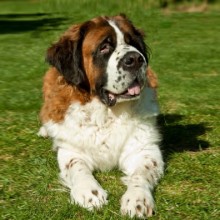Saint Bernard
Lifestyle Needs

The Saint Bernard is a very large and heavy dog, related to Swiss mountain rescue dogs. His coat is dense and thick and will need daily grooming. Although reputedly very strong the Saint Bernard no longer works. His size alone means that he does not make an ideal family pet. He needs training as a puppy and adequate socialisation with people and other dogs. As a puppy special care needs to be taken over his diet and exercise to protect his fast growing bones. The average life span of a Saint Bernard is only 8 years.
Genetic Diversity
(Known as Coefficient of Inbreeding: 'COI'. It should be as low as possible.)
The UK Kennel Club breed average COI is 5.0% - See 'A Beginners Guide to COI'
Gene Pool Size
(Known as Effective Population Size: 'EPS')
130.6
EPS is a measure of how many individuals are contributing genetically to a breed population. It is a measure of the size of the gene pool in a breed. Lower than 100 is considered critical by conservationists and below 50 brings a breed close to extinction. For more information see the Kennel Club article.
Health and Welfare Problems due to Conformation
(Body shape and physical characteristics)
- The Saint Bernard’s large and heavy size puts a strain on his heart and bone joints and restricts his ability to enjoy life as a dog should.
- Gastric dilatation volvulus (GDV) Bloat/Torsion
- Drooling, due to loose skin and skull shape
BVA/KC Health Schemes: www.bva.co.uk/chs
- Hip dysplasia: breed 5 year mean score 21.4 (parents should be lower)
- Elbow dysplasia: score ideally O:O)
- Eye disease
The Saint Bernard is one of the 15 high profile breeds designated by the Kennel Club as requiring particular monitoring by reason of visible conditions which may cause health and welfare concerns.
Estimated Breeding Values (EBVs) : No EBVs are currently available for this breed
www.thekennelclub.org.uk/about-ebvs
DNA Tests Available
DogWellNet and IPFD Harmonisation of Genetic Testing for Dogs (HGTD)
www.dogwellnet.com/breeds
- Polyneuropathy
- Juvenile onset inherited laryngeal paralysis
Availability of a DNA test does not mean that it is always necessary or even desirable for breeders to use this test.
Other Breed-Specific Health Screening Schemes
Bitches not to produce a litter under 2 years of age.
Ask the breeder to show you the certificates for the above tests/screening for both parents. If any of the above tests have not been considered necessary by the breeder (and there may be good reasons), ask her to explain why.
Other Diseases Reported
(For which there are currently no genetic or screening tests for sire or dam)
- Heart disease: Dilated cardiomyopathy (DCM)
- Dermatitis
- ‘Cherry Eye’
- Cranial cruciate ligament disease (CCL)
- Cancer: Osteosarcoma
- Entropion/Ectropion
- Ear infections
- Epilepsy
- Panosteitis
Ask the breeder about the medical history of the parents, grandparents and great grandparents. Consider carefully whether to purchase a puppy if some of these or other diseases are in the family line.
Ask about the breeder’s policy in cases of serious genetic diseases occurring to your puppy in later life. Good breeders will request to be informed of such events in order to improve future breeding decisions.
You are strongly advised to buy from a breeder who uses (or is prepared to use) the AWF Puppy Contract and Puppy Information Pack (PIP): www.puppycontract.org.uk
The breeder should also be familiar with the CFSG/DBRG Code of Practice for Dog Breeding